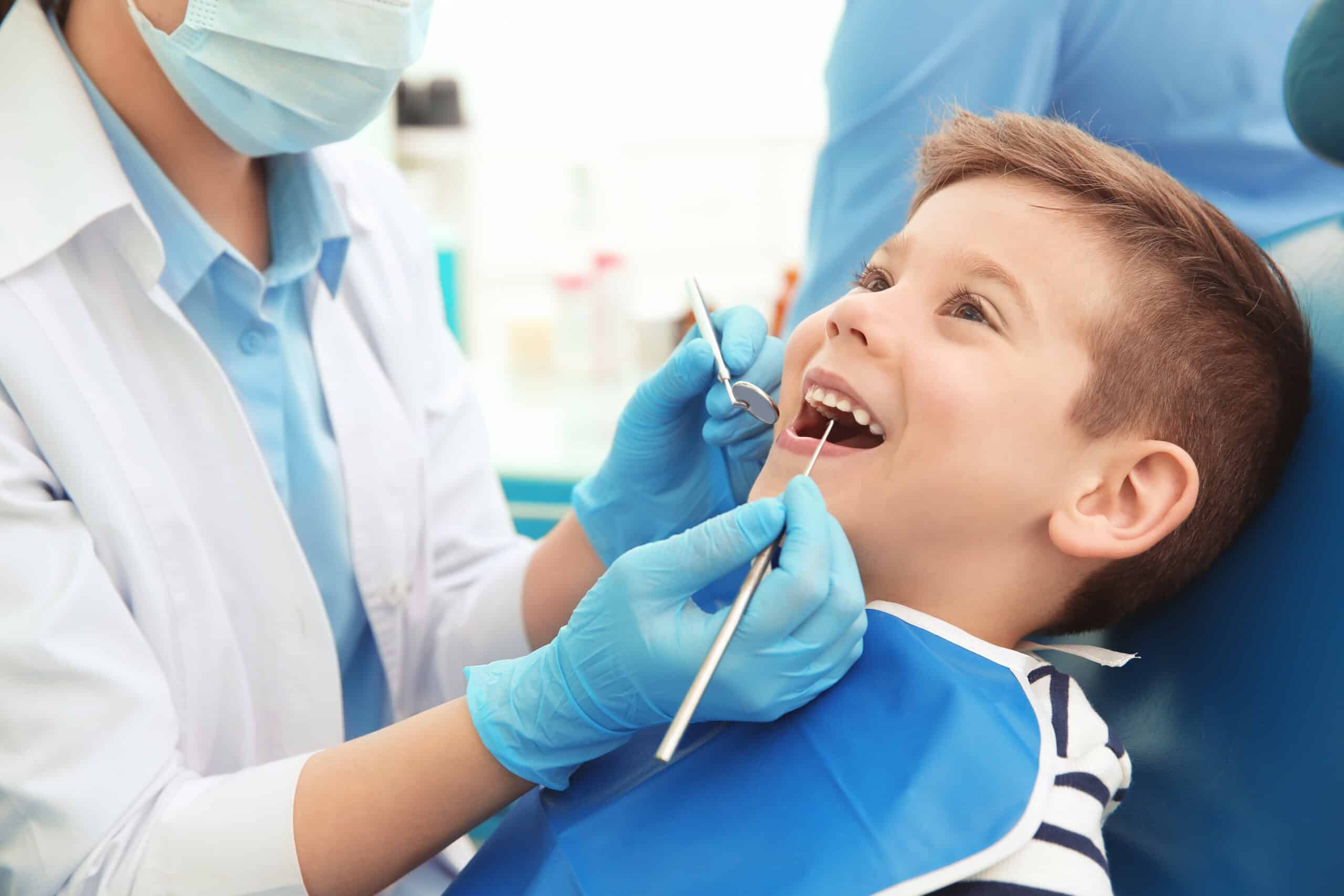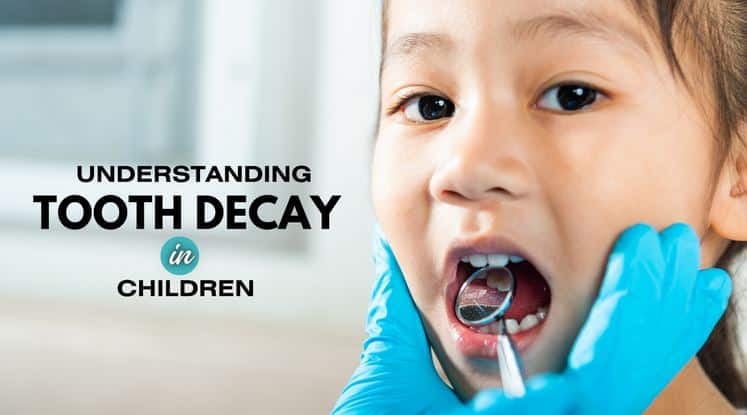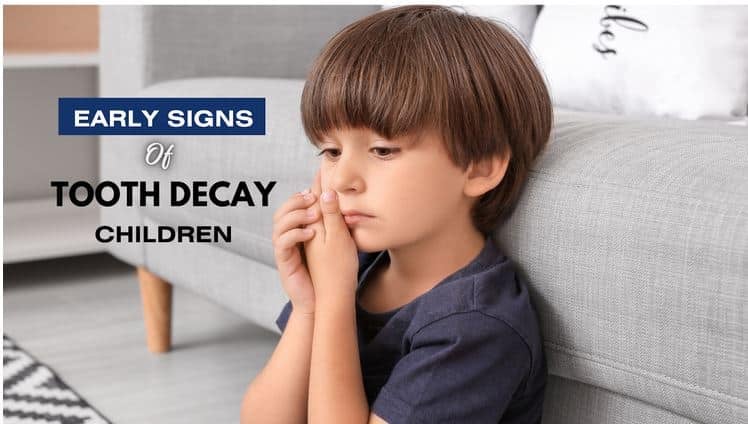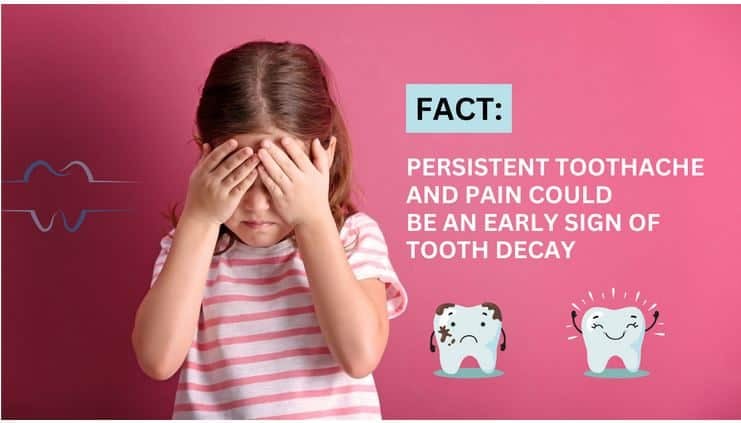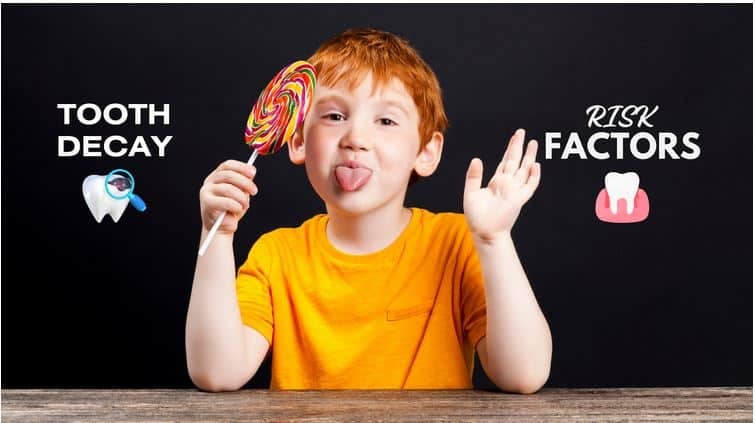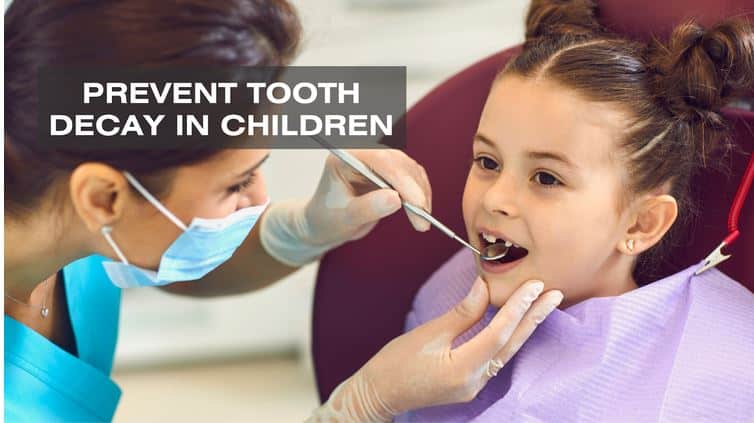Tooth decay in children is a serious concern for parents.
The average number of teeth affected by decay in Canadian children between the ages of 6-11 years old is 2.5, according to the Canadian Health Measures Survey.
Yet, within this challenge lies an incredible opportunity: to safeguard your child’s health and happiness.
In this article, we’ll explore the early signs of tooth decay in children and share strategies needed to protect those precious smiles.
What is Tooth Decay in Children?
Tooth decay in children is the process of cavities or caries forming in the teeth. It occurs when bacteria in the mouth produce acids that erode the tooth’s enamel.
This demineralization leads to the development of small holes or cavities in the teeth, causing pain, sensitivity, and potential damage if left untreated.
Understanding Tooth Decay in Children
Tooth decay is every parent’s nightmare. It was mine too!
A few years ago, my daughter came home from school one day, her face scrunched up in pain, and tears in her eyes. She could barely chew her favorite cookie.
After an anxious visit to the dentist, we learned that her teeth were under attack from those sneaky bacteria. It hit home that tooth decay could affect any child. No one is immune.
Early Signs of Tooth Decay
Seeing your child suffer is unbearable. I still remember my girl’s face when she showed me white spots on his teeth. Those were the early signs of tooth decay.
It’s like a wake-up call, isn’t it? Your child may not always express their discomfort, but those white spots speak volumes.
Whenever you notice any of these 7 early signs in your child, they could be warning signs of tooth decay:
1. Tooth Sensitivity:
If your child is wincing in pain as they sip on a cold drink or enjoy their favorite ice cream, this might be a sign of an even bigger tooth disease.
Tooth sensitivity can be a cruel messenger of tooth decay, bringing discomfort and fear, and nudging you to act quickly.
2. White Spots:
These are tiny, chalky white spots on your child’s teeth, like the first cracks in a precious vase. These spots signify the beginning of enamel erosion, a sign that the teeth need your protection to avoid further damage.
3. Discoloration:
Dark spots or holes on your child’s teeth are more than just visual blemishes.
They’re like ominous clouds in the sky, warning of an impending storm. These visual cues signal advanced tooth decay that demands immediate attention.
4. Toothache or Pain:
There’s nothing quite as heart-wrenching as seeing your child in pain.
When they complain of a persistent toothache, it’s like hearing their cries for help.
It’s a clear indication that the decay has reached a critical point, and your child’s well-being is at stake.
5. Bad Breath (Halitosis):
Persistent bad breath may pose a bigger social problem for the child if left untreated. It’s like a cloud that follows them around, affecting their self-esteem.
Bad breath can be an early indicator that something is amiss in their oral health.
6. Changes in Eating Habits:
Your child suddenly avoiding certain foods or favoring one side of their mouth while eating is a subtle yet impactful sign.
It’s like a distress signal, indicating that their teeth may be in trouble, and it’s altering their eating habits.
7. Sleep Disturbance:
Tooth decay doesn’t spare nighttime peace. When your child’s tooth pain disturbs their sleep, it’s like a haunting specter in the night.
Their restlessness is a cry for help, urging you to address the dental issue causing their discomfort.
These early signs are not just signals of dental issues but emotional experiences for both you and your child.
Note: When you recognize and address these early signs, you can be sure that your child’s smile will remain a source of happiness and not one of pain and fear.
Regular dental check-ups are crucial, especially if you want to always stay on top of your child’s lovely smiles and overall oral health.
Risk Factors for Children
Let me share something that might surprise you. In my journey as a parent, I discovered that our diet plays a massive role.
Let’s examine the 5 common risk factors for tooth decay in children:
- Sugary Foods and Beverages: Excessive consumption of sugary items contributes to decay.
- Poor Oral Hygiene: Inadequate brushing and flossing allow bacteria to thrive.
- Lack of Fluoride: Insufficient fluoride exposure weakens tooth enamel.
- Genetics: Family history may increase susceptibility to decay.
- Infrequent Dental Check-ups: Missed check-ups can result in undetected issues.
How to Prevent Tooth Decay in Children
Here’s what you need to know:
Prevention is a parent’s superpower. I realized the importance of this when my daughter’s dentist became our ally in the battle against tooth decay.
To help you prevent and fight tooth decay in children, here are the 7 effective measures that work:
1. Regular Dental Check-ups:
Regular dental check-ups are your guiding hand.
These visits are your opportunity to catch issues early and receive expert guidance. They become an essential part of your child’s routine, fostering trust and comfort with the dentist. Never miss it or treat it lightly.
2. Teach Proper Oral Hygiene:
One of the greatest gifts you can give your child is the knowledge of proper oral hygiene.
Brushing and flossing should become habits as ingrained as saying “please” and “thank you.” Encourage your child to embrace this routine as a daily adventure, not a tiresome chore.
3. Choose a Balanced Diet:
Your child’s diet plays a significant role in preventing tooth decay.
Just as you would provide them with a balanced meal, ensure their snack choices are tooth-friendly.
Limit sugary and acidic foods and encourage healthier alternatives like fruits and vegetables.
4. Fluoride and Dental Sealants:
Think of fluoride as your secret weapon in this battle. It strengthens tooth enamel and helps prevent decay.
Similarly, dental sealants are like shields that protect vulnerable areas of the teeth from bacteria. These professional treatments are potent tools in your armory.
5. Set a Positive Example:
Children learn by observing. Make oral care a family affair, and show them that taking care of your teeth is a shared adventure.
Brush together, visit the dentist as a family, and create a positive atmosphere around oral health.
6. Make It Fun:
Like my daughter’s dentist who spun stories about teeth, they make dental care fun.
Let your child choose a toothbrush with their favorite character, sing songs during brushing, and celebrate each successful brushing adventure with a small reward.
7. Water and Dental Hygiene:
Encourage your child to drink water, which can help rinse away food particles and acids. It’s like nature’s mouthwash.
Plus, water often contains fluoride, offering additional protection.
These strategies are your roadmap to preventing tooth decay in children.
Just as my daughter left the dental chair with a smile, you can make this journey an adventure rather than a chore.
FAQs about Children’s Tooth Decay
There are too many questions that need some answers. Let’s explore some of them:
1. Do baby teeth really decay, and should I be worried about it?
Yes, baby teeth can develop cavities, and it’s a matter of concern. Although baby teeth eventually fall out, they play a crucial role in your child’s oral development.
Tooth decay in baby teeth can lead to pain, difficulty eating, and potential infections. It’s vital to care for these teeth to ensure your child’s comfort and overall oral health.
2. At what age should I start taking my child to the dentist?
The American Academy of Pediatric Dentistry recommends that you schedule your child’s initial dental appointment as soon as their first tooth breaks through, or ideally by their first birthday.
These early visits are essential for the dentist to keep a close eye on your child’s oral health, provide valuable advice on proper care, and lay the groundwork for a lifetime of dental well-being.
3. Are fluoride toothpaste and water safe for kids?
When used correctly, fluoride is safe and beneficial. Fluoride strengthens tooth enamel and aids in preventing tooth decay.
Ensure your child uses a pea-sized amount of fluoride toothpaste appropriate for their age and supervise their brushing.
Public water supplies with added fluoride contribute positively to dental health.
4. How can I make dental care enjoyable for my child?
Transform dental care into an adventure. Let your child choose a vibrant, child-friendly toothbrush and maybe a toothpaste with their favorite flavor.
Create an engaging brushing routine, perhaps using a timer or playing their favorite song. Encourage them with positive reinforcement, like a sticker chart for successful brushing.
5. What signs should I watch for as indicators of tooth decay in my child?
Keep an eye out for signs like toothaches, sensitivity to hot or cold foods, white spots on their teeth, dark spots, or holes.
If your child experiences persistent bad breath or faces difficulties while chewing, these could also be signals of tooth decay.
Regular dental check-ups are crucial to detect and address these issues in their early stages.
Preventing Tooth Decay in Children: Takeaway
All in all, the best way to keep tooth decay away is to identify and prevent it. It’s no longer a mere choice, but a must.
It’s not just about rescuing teeth; it’s about safeguarding your child’s health, self-assurance, and future.
You’re not alone in this journey. We’ve got each other, and we have access to the tools and expertise to fight tooth decay in children.
So embrace dental check-ups religiously, and watch your child’s smile grow brighter and healthier every day.

